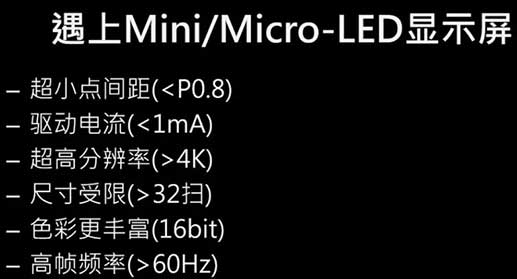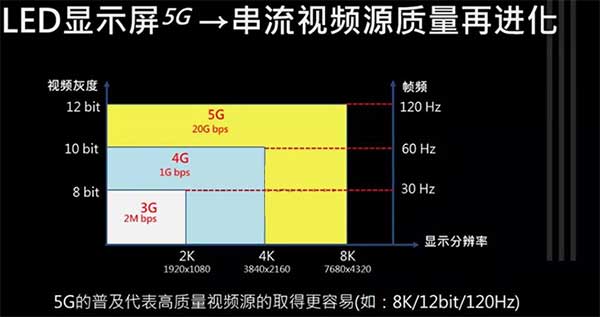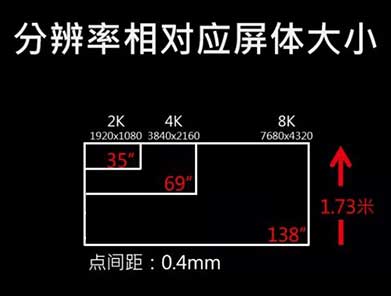With the arrival of the 5G era, a global wave of 5G enthusiasm has begun. In addition, various regions across the country have issued guidelines for "4k first, taking into account 8k", marking the development of the LED electronic large screen industry towards the era of ultra high definition LED displays. Although 5G commercialization has already landed, LED display manufacturers still need to solve the Mini/Micro LED problem if they want to catch the 5G express.

LED display manufacturers need to solve the Mini/Micro LED problem if they want to ride the 5G fast train
China has only taken a few decades to transition from the 2G era to the 5G era, and has achieved overtaking in the curve. 5G technology is already ahead of foreign levels. The LED electronic large screen industry is no exception. The transition from single red to dual color and then to full-color, as well as the current P0.X micro pitch LED display screen, only took a few decades to achieve overtaking, and some small pitch LED display screen technologies have far surpassed foreign levels. Of course, the rapid progress of technology in various industries in China is closely related to the continuous improvement of the country's comprehensive strength level.
Of course, the arrival of the 5G era is both an opportunity and a challenge for major LED display manufacturers. The transmission rate of 3G is 2Mbps. At this time, the video source of the LED electronic large screen only needs to meet 8-bit color and grayscale levels, 2k resolution, and 30Hz frame switching frequency. The transmission rate of 4G is 1Gbps, and the video source of high-definition LED display screen needs to meet 10 bit color and grayscale levels, 4k resolution, and frame switching frequency of 60Hz. And nowadays, the frame changing frequency of LED displays produced by LED display manufacturers is basically 60Hz/S.
However, the arrival of the 5G era means higher transmission speeds. In theory, the peak transmission speed of 5G can reach 1GB every 8 seconds, which is more than 10 times faster than 4G. Therefore, 5G also requires video sources for ultra high definition LED displays to achieve 12 bit color, 8k resolution, and a frame rate of 120Hz per second. In the future, 8k ultra high definition LED displays will become the trend. So nowadays, major LED display manufacturers are actively deploying the research and innovation of 5G+8k ultra high definition LED screens.

If traditional large pitch LED electronic screens are seamlessly spliced point-to-point to achieve 8k ultra-high definition resolution, it may require hundreds or even thousands of square meters. For users, such a large screen not only needs to consider installation space, but also product costs, after-sales maintenance, and installation construction costs, which require a lot of manpower and material resources. For end customers, it is obviously not realistic. Therefore, LED display manufacturers can only continuously reduce the dot pitch. Although SMD packaging technology is already mature, for P0-X micro pitch LED displays, not only is the virtual soldering rate and dead light rate high, but the cost is also relatively high. To this end, LED display manufacturers and upstream packaging manufacturers have developed COB, four in one Mini LED, and Micro LED packaging technologies, which can achieve mass production of P0.X micro pitch and higher product stability.
Taking P0.9375 micro pitch LED display screen as an example, if you want to seamlessly splice it into a 4k resolution screen, the screen size is 163 inches. If you want to install 5G network, you must upgrade the screen resolution to 8k ultra high definition resolution, and 8k resolution is four times that of 4k resolution. Therefore, the display size of the 8k P0.9375 small pitch LED display screen is 325 inches, which is 4 meters high. For large conference rooms, a 4-meter-high screen is obviously not a problem, but for most floors with only 2 to 3 meters of space, installing an 8k ultra high definition LED display screen is clearly not realistic.
But if LED display manufacturers develop smaller micro pitch LED screens, their screen size will naturally decrease accordingly. For example, if the P0.75 micro pitch LED display screen needs to be spliced into an 8k resolution, the height of the screen is 3.24 meters. If the height of the floor is greater than this display size, then there is no problem, but if it is less than this height, it naturally cannot achieve a 5G+8k high-definition resolution screen. Therefore, if you want to meet the height of most building floors while also achieving 8k high-definition resolution, you must use smaller pitch LED display screens. For example, if P0.625 micro spacing is to be spliced into an 8k resolution, its height is 2.7 meters, which is undoubtedly a good choice for most building floors.
The screens in mainstream video conference rooms are still mainly touch screens, but so far, LED display screens produced by LED display manufacturers obviously cannot achieve touch operation. Although some LED screen companies use film coating to solve the unevenness caused by touch, the effect is still not very ideal. More LED screen companies will participate in the touch screen technology in the future, but this initiative will still take a long time to complete.
For most conference rooms, they are for close range viewing. Therefore, if LED display manufacturers want to seize this niche field of conference rooms, they must continuously reduce the dot pitch and lower the screen brightness to ensure that long-term viewing does not cause visual fatigue to the human eye. For a conference room, if the distance between points can reach 0.4mm and the height of the screen is only 1.73 meters, which is about the same height as a person, it is ideal for both personal presentations and group discussions. If LED screen companies want to replace LCD, they can reduce the dot pitch of LED displays to 0.4mm, provided that the technical challenges of Mini LED and Micro LED are solved.

Of course, 8k ultra high definition video means a larger bandwidth is required, and 5G technology can obviously meet this requirement. However, for the LED electronic large screen industry, it needs to meet a frame switching frequency of 120Hz, which is obviously not suitable for the mainstream 60Hz. Therefore, major LED screen companies need to continuously increase the frame switching frequency, because the high frame frequency video format of 120Hz can cause problems in image data transmission and image transmission for LED displays. This requires the use of DCLK dual edge triggering and GCLK internal oscillation technology in the driver architecture to restore the video source.
Therefore, if LED display manufacturers want to ride the 5G fast, they must solve the technical problems of Mini LED and Micro LED. For example, the point spacing should be below 0.8mm, and the driving current should be less than 1mA, because the resolution of small spacing will be higher, and the number of light beads will also increase geometrically. If the current is too large, it will inevitably affect the power and heat generation of the screen, affecting the stability of the screen. And the resolution of the display screen should meet 4k, and in the next few years, it should meet 8k ultra high definition resolution.
In addition, due to size limitations, the number of scans driven must be greater than 32 scans. As the number of LED chips increases exponentially, the number of driver chips will also increase. The placement of chips needs to be redesigned, and the ultra small dot spacing means a higher number of scans. Therefore, in the future, the number of scans with micro spacing will exceed 32 scans. In addition, an 8k resolution means richer colors. The input video is 12 bits, and the required output light grayscale is 16 bits, which is also a great challenge for the driver chip. Another requirement is high frame frequency, which ranges from 60Hz to 120Hz.
In summary, 5G+8k is the mainstream for the future development of the display industry, and LED display manufacturers need to solve the Mini/Micro LED problem if they want to catch the 5G express. 8k ultra high definition resolution means a higher resolution LED electronic screen is needed, so while the dot pitch needs to be continuously reduced, the driving current also needs to be continuously reduced, the size is limited by the installation space and needs to be continuously reduced, the colors need to be richer, and the frame switching frequency needs to be higher.